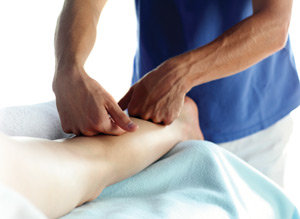Rubbing Away Pain
Dawn Dellasanta-Swann writer

A row of high windows floods Dianna Philipps’ downtown Needham office with afternoon sunlight. A grinning skeleton dangles near the edge of a plush Persian rug. There’s a bookshelf full of texts, a low massage table covered in a red sheet, and Phillips herself, long hair piled on the back of her head, legs tucked away beneath her as she sits on one of the two comfy chairs by the front of the room.
Phillips, a Wellesley resident, is a certified “Rolfer,” one of only about eight in the metro-Boston area. While Rolfing, a deep tissue procedure, is still rare, the larger community of practitioners trained to squeeze, rub, and push away body aches is flourishing. Need to know where to go? First know what you need, starting with a working knowledge of massage theory.
Bodywork Basics
Matt Major of Major Massage says the need for bodywork is twofold: People generally walk into an office wanting either therapeutic treatment for injury and pain or they want pure relaxation. Though modalities run the gamut, those objectives tend to overlap.
“Healing comes from the person who comes in,” says Jessica O’Brien, director of Bella Santé Day Spa. Bella Santé offers therapies ranging from a treatment that includes a luxurious, ten-head shower and a new, cutting-edge bamboo massage to the traditional, relaxing Swedish-based massage. With this type of massage, you can expect long strokes, kneading, and circular movements that manipulate the superficial layer of muscles beneath the skin.
At the other end of the spectrum are those therapists like Phillips and Major who work deep into the myofascial tissue.
“Fascia,” Major explains, “is a protein fiber that surrounds every muscle, every muscle fiber, ligaments, and tendons. Fascia is kind of cool. Imagine Jell-o.” When hot, Jell-o is liquid. After an hour or so in the fridge, it’s solid. Stick a whisk in it and stir, and it’s back to being liquid again.
While never actually liquid, fascia softens when our bodies are warm and firms when cool. Unfortunately, the connective tissue doesn’t make allowances for bad habits like poor posture. The fascia of someone who hunches over a keyboard for eight hours a day, slouches home on the commuter rail, and then spends the evening slumped in front of the television will eventually fix into a droopy position. “From an evolutionary perspective,” says Major. “We are not doing what we are designed to do. We used to live lives of hunting and running from saber toothed tigers.” But bodywork can fix that.
Changing Fascia and Rolfing
Developed by and named after the late New York City biochemist, Ida Rolf, Rolfing operates on the principle that gravity can work with the body rather than against it, as so many of us lament. The key is correct alignment. Chiropractors manipulate joints and bones to achieve alignment. Rolfers delve into the fascia. Remember Major’s Jell-o metaphor? In that scenario, Rolfing acts like the whisk that brings the Jell-o back to its malleable form so that it may set again correctly.
According to Phillips, Rolfing is not massage, and neither is it the sort of relaxing, candle-lit spa experience some people seek. Rolfing is aggressive, and, to be perfectly honest, it’s not always the greatest feeling on earth. But it works. A series of car crashes left Phillips with a case of whiplash that conventional medicine couldn’t touch. Rolfing fixed it. It usually takes about ten sessions to correct a problem, though Philips says there can often be positive change after about three.
 What to Expect
What to Expect
In Wellesley, Stefanie Gray greets clients in her neat-as-a-pin waiting room at Body Care of Wellesley. The floor is freshly swept, the glass sparkles, and there’s a comprehensive health questionnaire she asks new clients to answer placed on a wicker chair. German-born Gray is also neat, friendly, and confident. There is no question during the brief pre-massage interview as to whether or not she knows what she is doing. She does. Yet, she is in no way intense. Soft, soothing music plays on a CD in the corner, and Gray settles onto an exercise-ball chair where she chats with her clients in order to get an idea about the session’s goals. Questions include sleep history, whether or not there are any aches or pains, and how much stress, on a scale of 1 to 10, is present. She’s getting a picture of how her client’s body works, overall health, and what she needs to do.
A reputable practitioner will always conduct this pre-treatment interview. During a Rolfing session, the client undresses to his or her undergarments — or to a tank top and leggings in my case — and walks across the room. At the massage therapist’s office, the client undresses to his or her own comfort level and slides beneath a clean sheet.
Gray has hands that can find “sweet spots,” a talent she has had since she was little and discovered that she wanted to be a massage therapist. Even still, she advises her clients to speak up if something doesn’t feel right. Massage is low risk. About the worst thing you can expect is to leave the table unsatisfied. But too much pressure can cause muscles to tense. Too little pressure may not get the job done. This is your time, your therapy. Own it.
Muscle Theory
Richard Tung of Richard Tung Massage Muscle Therapy says massage can increase performance in athletes, reduce recovery time, and break up the inner scar tissue that occurs from low-impact accidents. Our generation’s common aches, like those incurred after long hours at the computer, can benefit from therapeutic massage. “Your head is like a bowling ball resting on a stack of dimes,” says Tung. Poor posture can strain the muscles that keep the bowling ball from rolling off.
Rolfers and massage therapists need to be well versed in anatomy and physiology. “We can’t diagnose,” Tung is careful to point out, “but we can assess.” Tung remembers a book he read in which around seven hundred different muscles were identified. That’s around seven hundred different ways for the human body to feel muscle pain. Tung recalls a massage using cotton swabs to manipulate the tiny muscles around the eyes and one that worked the inside muscles of the mouth and jaw. “Massage breaks up the pain/spasm/pain cycle,” explains Tung. No matter where it is.
Majors calls cells little biological factories. They take in energy, use it to do something, and then the blood carries away the metabolic waste. If you are dehydrated, if you don’t get enough exercise, or if your muscles are too tight, blood flow suffers and metabolic waste pools. Massage loosens muscles and improves circulation.
Who Shouldn’t Get Massage
Jill Grignaffini, owner of Grignaffini Muscular Therapy, says that there is a massage modality for everyone. Massage therapists work on clients with needs ranging from deep, myofascial work and injury recovery all the way to the prenatal needs of expectant mothers and lymphatic drainage for cancer patients.
She does, however, caution certain people against massage. Since massage is so effective at circulating the blood, it tends to raise the blood pressure slightly. Patients with controlled high blood pressure should check with their doctor to be sure that massage is safe. Grignaffini says that massage is not for anyone “who has had a stroke in the last six months, and after six months, they should get permission from their doctor.” Patients with heart disease should consult their doctor as well, though usually it’s okay.
And Lastly
Make sure your practitioner is licensed and certified to practice the form of therapy he or she plans to use, especially for clients with chronic pain or lingering injury. Check out their space as well. When it comes to body work, appearance is important. Your practitioner should be dressed neatly and appear clean, and the office should be likewise neat and clean. It’s hard to relax in a place that makes you feel uncomfortable with a person you’d rather not have touching your body.
Tell your practitioner about injuries and food allergies that could be triggered by the ingredients in massage creams. Don’t be afraid to ask for work on a specific area. Major says a relationship with a massage therapist is a strange one. One in which you meet someone for the first time, remove your clothing, and they touch you. For that reason, be comfortable with whom you select. And when you are comfortable, lay back, relax, and feel better. ![]()
Ready to find the right practitioner? Start here.
© 2011 Elm Bank Media | Beth Furman, Publisher | Beth@ElmBankMedia.com


recent comments